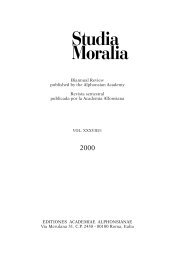Avant-propos - Studia Moralia
Avant-propos - Studia Moralia
Avant-propos - Studia Moralia
You also want an ePaper? Increase the reach of your titles
YUMPU automatically turns print PDFs into web optimized ePapers that Google loves.
180 TODD A. SALZMAN<br />
GRISEZ’S “high court” analogy does not end with the magisterial<br />
process of judgment but reflects what may be considered<br />
a punitive component for dissenting theologians as well. GRISEZ<br />
belittles the 1985 assembly of the SYNOD OF BISHOPS’ call for “reciprocal<br />
dialogue between the bishops and theologians…for the<br />
building up of the faith and its deeper comprehension” 29 given<br />
the current state of “radical dissent” within the Catholic Church.<br />
Instead, he <strong>propos</strong>es the remedies of the first assembly of the<br />
SYNOD in 1967. “Those who are rash or imprudent should be<br />
warned in all charity; those who are pertinacious should be removed<br />
from office.” 30<br />
This juridical model is based on certain premises. First, the<br />
magisterium “should respect” the scholarly authority of theologians.<br />
31 Second, rational arguments do not carry doctrinal<br />
weight. 32 Third, the special sacramental power of popes and bishops,<br />
through grace, gives them supernatural access to truth. 33<br />
Fourth, while recognizing that the magisterium can err in authoritative,<br />
noninfallible teachings, these teachings ought to be<br />
followed because “even when it is not clear that the bishop’s or<br />
pope’s teaching is <strong>propos</strong>ed infallibly, one has a good reason for<br />
assuming that his teaching pertains to divine revelation.” 34<br />
Fifth, the juridical model is based on a hierarchical ecclesiology<br />
represented, for example, in Humani Generis and Lumen<br />
Gentium 25. There is a curious tension here between the BGT reliance<br />
upon Humani Generis to defend the proper relationship<br />
between the magisterium and theologians and GRISEZ’S critique<br />
of this relationship prior to Vatican II. As he notes, “before Vatican<br />
II, too much conformity was demanded of Catholic theologians.<br />
Their work was so closely integrated with the magisteri-<br />
29<br />
SYNOD OF BISHOPS, “A Message to the People of God,” Origins 15/27 (December<br />
19, 1985) 441-50, at 447-48. Cited in GRISEZ, “How to Deal with Theological<br />
Dissent” 443.<br />
30 Cited in ibid. 444. See also, JOHN KIPPLEY, Fellowship of Catholic Scholars<br />
Newsletter 8 (September 1985) 9 (cited in MCCORMICK, Critical Calling 25).<br />
31<br />
GRISEZ, “How to Deal with Theological Dissent” 460.<br />
32<br />
GRISEZ, Christian Moral Principles 853, 856.<br />
33 Ibid. chapt. 35.<br />
34 Ibid. 852 (emphasis omitted).

















